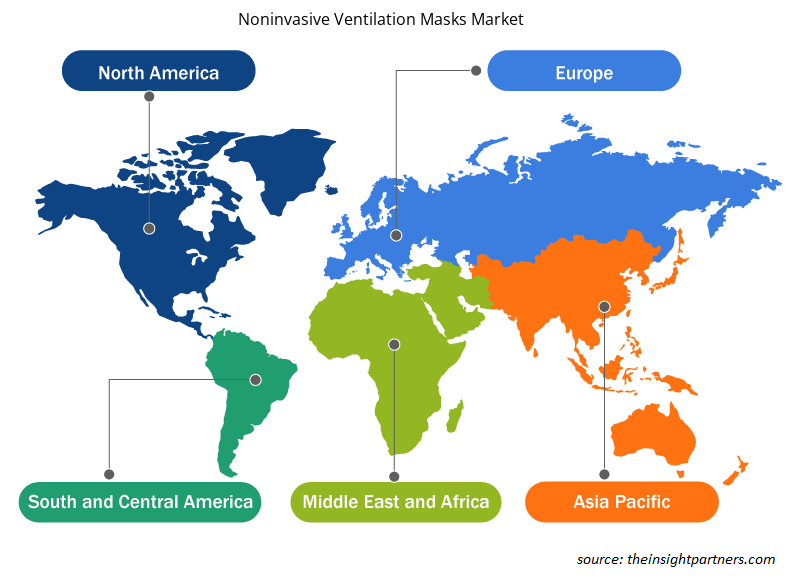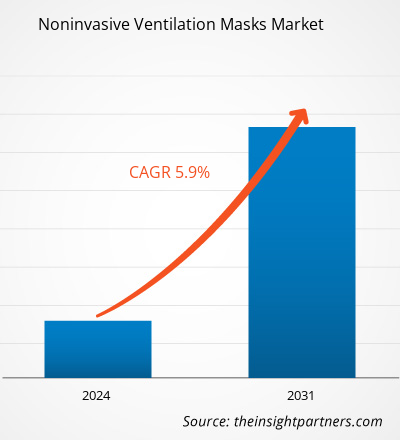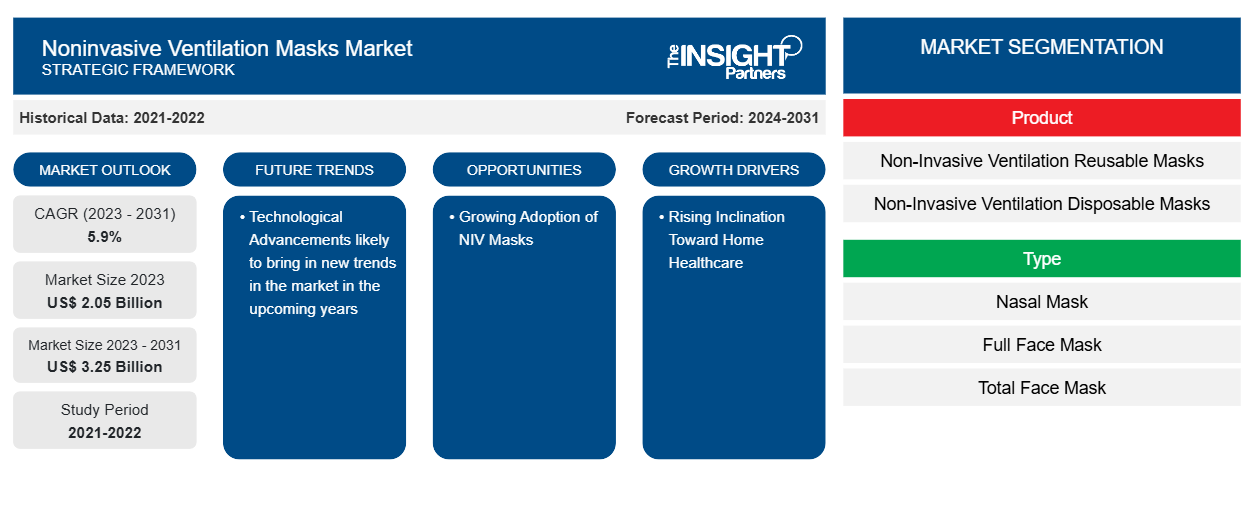Le marché des masques de ventilation non invasive devrait atteindre 3,25 milliards de dollars américains d’ici 2031, contre 2,05 milliards de dollars américains en 2023. Le marché devrait enregistrer un TCAC de 5,9 % au cours de la période 2023-2031. Les avancées technologiques croissantes dans le domaine des masques de ventilation non invasive sont susceptibles de constituer une tendance future sur le marché dans les années à venir.
Analyse du marché des masques de ventilation non invasifs
Les méthodes de ventilation invasive sont souvent évitées chez les patients atteints de BPCO afin de réduire les risques de complications telles que les infections et les lésions pulmonaires mécaniques. Les masques de ventilation non invasive sont préférés car ils fournissent une assistance respiratoire sans nécessiter d'intubation. Ainsi, la nature chronique et à long terme de la BPCO et de l'apnée du sommeil conduit à des achats répétés et crée une demande de masques de ventilation non invasive, générant ainsi un marché stable et durable pour les fabricants.
Aperçu du marché des masques de ventilation non invasifs
Selon les estimations du National Council on Aging, Inc., 39 millions d'adultes aux États-Unis souffraient d'AOS en 2023. Selon un article intitulé « Que sait une population suisse fragile de la bronchopneumopathie chronique obstructive ? », environ 400 000 personnes en Suisse souffraient de BPCO en 2021. La ventilation non invasive (VNI) consiste à administrer un apport d'oxygène au moyen d'un masque facial, éliminant ainsi le besoin d'une voie endotrachéale dans le traitement de diverses affections, notamment la BPCO, l'œdème pulmonaire cardiogénique et d'autres affections respiratoires sans complications telles que la faiblesse des muscles respiratoires, les traumatismes des voies respiratoires supérieures et la pneumonie associée au respirateur. Les masques de ventilation non invasive peuvent être réutilisables ou jetables. Les masques de ventilation non invasive jetables sont à usage unique et sont jetés pour réduire le risque de contamination croisée. Les progrès dans la conception des masques, le confort, la durabilité et l'incorporation de matériaux respectueux de la peau peuvent stimuler l'adoption des masques VNI, car les patients recherchent des produits plus efficaces et plus confortables. Ainsi, l’adoption des masques NIV comme traitement efficace de ces affections respiratoires répandues devrait continuer à stimuler la croissance du marché des masques de ventilation non invasive au cours de la période 2023-2031.
Personnalisez ce rapport en fonction de vos besoins
Vous bénéficierez d'une personnalisation gratuite de n'importe quel rapport, y compris de certaines parties de ce rapport, d'une analyse au niveau des pays, d'un pack de données Excel, ainsi que de superbes offres et réductions pour les start-ups et les universités.
-
Obtenez les principales tendances clés du marché de ce rapport.Cet échantillon GRATUIT comprendra une analyse de données, allant des tendances du marché aux estimations et prévisions.
Facteurs moteurs et opportunités du marché des masques de ventilation non invasifs
La demande croissante pour les soins à domicile stimule le marché
Le passage des établissements de soins de longue durée, de réadaptation pour patients hospitalisés et d'établissements de soins infirmiers spécialisés aux soins à domicile se traduit par une interaction meilleure, cohérente et rapide entre le patient et le médecin grâce au cloud et aux appareils médicaux basés sur la mobilité . L'épidémie de COVID-19 a révélé l'importance des soins à domicile en raison de la capacité limitée des lits d'hôpitaux et de la pénurie de professionnels de santé qualifiés. Grâce aux soins à domicile, les professionnels de santé peuvent surveiller les signes vitaux des patients à distance et éviter les admissions à l'hôpital.healthcare's importance due to limited hospital bed capacity and a scarcity of skilled healthcare professionals. With the help of home healthcare, healthcare professionals can monitor patient's vitals remotely and avoid hospital admissions.
De plus, les patients souffrant de maladies telles que la BPCO, l’apnée du sommeil et d’autres problèmes respiratoires expriment de plus en plus leur préférence pour la gestion à domicile de leurs maladies. Les patients peuvent utiliser la thérapie NIV dans le confort de leur domicile sans avoir à se rendre fréquemment à l’hôpital. Les prestataires de soins à domicile prescrivent de plus en plus fréquemment des masques NIV dans le cadre de plans de soins respiratoires complets.COPD, sleep apnea, and other respiratory issues are increasingly expressing a preference for at-home management of their ailments. Patients can use NIV therapy in the comfort of their homes without having to make frequent visits to the hospital. Home healthcare providers are prescribing NIV masks more frequently as a component of all-encompassing respiratory care plans.
Par conséquent, en raison de l’attrait croissant pour les soins de santé à domicile et de la demande croissante d’appareils plus avancés, abordables et facilement utilisables à domicile, le marché des masques de ventilation non invasive gagne du terrain.
L'adoption croissante des masques NIV offre des opportunités de marchéNIV Masks to Offer Opportunities for Market
Les masques de ventilation non invasive deviennent de plus en plus populaires et élargissent les opportunités de marché en stimulant l'innovation. Un diagnostic et un traitement plus précoces sont rendus possibles par des campagnes de sensibilisation croissantes sur les troubles respiratoires tels que la BPCO, l'apnée du sommeil et d'autres. La prescription et l'utilisation accrues de masques NIV pour la gestion des maladies résultent d'une plus grande sensibilisation des patients et des professionnels de la santé. Ainsi, la prise de conscience émergente du diagnostic précoce est susceptible de favoriser l'adoption des masques NIV et de créer des opportunités importantes sur le marché. De plus, les maladies respiratoires deviennent plus courantes dans les économies émergentes, en particulier en Asie-Pacifique, en Amérique latine et au Moyen-Orient, en raison de la pollution, de l'urbanisation et des changements de mode de vie. Les thérapies non invasives sont de plus en plus connues dans ces régions, grâce à quoi l'utilisation de masques NIV devrait continuer à progresser au cours de la période de prévision.COPD, apneaNIV masks for disease management results from greater awareness among patients and healthcare professionals. Thus, emerging awareness of early diagnosis is likely to drive the adoption of NIV masks and create significant opportunities in the market. Moreover, respiratory illnesses are becoming more common in emerging economies, particularly in Asia Pacific, Latin America, and the Middle East, due to pollution, urbanization, and lifestyle changes. The noninvasive therapies are becoming widely known in these areas, owing to which the use of NIV masks is likely to continue to propel during the forecast period.
Analyse de segmentation du rapport sur le marché des masques de ventilation non invasifs
Les segments clés qui ont contribué à l’élaboration de l’analyse du marché des masques de ventilation non invasive sont le produit, l’application et l’utilisateur final.
- En fonction du produit, le marché des masques de ventilation non invasive est divisé en masques jetables de ventilation non invasive et masques réutilisables de ventilation non invasive. Le segment des masques jetables de ventilation non invasive détenait une part plus importante du marché des masques de ventilation non invasive en 2023.
- En fonction des applications, le marché est segmenté en apnée obstructive du sommeil, bronchopneumopathie chronique obstructive, pneumonie et autres. Le segment de l'apnée du sommeil détenait la plus grande part du marché des masques de ventilation non invasive en 2023.apnea, chronic obstructive pulmonary disease, pneumonia, and others. The sleep apnea segment held the largest share of the noninvasive ventilation masks market in 2023.
- En fonction de l'utilisateur final, le marché est segmenté en hôpitaux et cliniques, soins à domicile et autres. Le segment des hôpitaux et des cliniques détenait la plus grande part du marché des masques de ventilation non invasive en 2023.
Analyse des parts de marché des masques de ventilation non invasifs par géographie
Français La portée géographique du rapport sur le marché des masques de ventilation non invasive est principalement divisée en cinq régions : Amérique du Nord, Asie-Pacifique, Europe, Amérique du Sud et centrale, et Moyen-Orient et Afrique. L'Amérique du Nord a dominé le marché en 2023. Les États-Unis sont le marché le plus important et celui qui connaît la croissance la plus rapide pour les masques de ventilation non invasive. Selon l'American Medical Association, environ 30 millions de personnes aux États-Unis souffraient d'apnée du sommeil en 2022 ; cependant, seulement 6 millions ont été dépistées pour cette condition. En outre, environ 14,8 millions d'adultes ont reçu un diagnostic de BPCO la même année, qui est la quatrième cause de décès aux États-Unis. La prévalence croissante de ces maladies pulmonaires chroniques devrait augmenter la demande d'options de traitement NIV, stimulant ainsi la croissance du marché des masques de ventilation non invasive aux États-Unis.
En outre, la présence d'acteurs majeurs du marché, tels que Sleepnet Corporation, Philips et Hamilton Medical, qui proposent des masques NIV et les développements stratégiques de ces acteurs du marché aux États-Unis devraient augmenter la part de marché des masques de ventilation non invasive dans le pays au cours de la période de prévision. Par exemple, en août 2024, Sleepnet Corporation s'est associée à un hôpital pédiatrique américain renommé pour lancer le masque NIV Mini Me 2 afin d'étudier l'impact des dispositifs médicaux innovants sur les soins aux patients.
Aperçu régional du marché des masques de ventilation non invasifs
Les tendances et facteurs régionaux influençant le marché des masques de ventilation non invasifs tout au long de la période de prévision ont été expliqués en détail par les analystes d’Insight Partners. Cette section traite également des segments et de la géographie du marché des masques de ventilation non invasifs en Amérique du Nord, en Europe, en Asie-Pacifique, au Moyen-Orient et en Afrique, ainsi qu’en Amérique du Sud et en Amérique centrale.

- Obtenez les données régionales spécifiques au marché des masques de ventilation non invasifs
Portée du rapport sur le marché des masques de ventilation non invasifs
| Attribut de rapport | Détails |
|---|---|
| Taille du marché en 2023 | 2,05 milliards de dollars américains |
| Taille du marché d'ici 2031 | 3,25 milliards de dollars américains |
| Taux de croissance annuel composé mondial (2023-2031) | 5,9% |
| Données historiques | 2021-2022 |
| Période de prévision | 2024-2031 |
| Segments couverts |
Par produit
|
| Régions et pays couverts |
Amérique du Nord
|
| Leaders du marché et profils d'entreprises clés |
|
Densité des acteurs du marché des masques de ventilation non invasifs : comprendre son impact sur la dynamique commerciale
Le marché des masques de ventilation non invasifs connaît une croissance rapide, tirée par la demande croissante des utilisateurs finaux en raison de facteurs tels que l'évolution des préférences des consommateurs, les avancées technologiques et une plus grande sensibilisation aux avantages du produit. À mesure que la demande augmente, les entreprises élargissent leurs offres, innovent pour répondre aux besoins des consommateurs et capitalisent sur les tendances émergentes, ce qui alimente davantage la croissance du marché.
La densité des acteurs du marché fait référence à la répartition des entreprises ou des sociétés opérant sur un marché ou un secteur particulier. Elle indique le nombre de concurrents (acteurs du marché) présents sur un marché donné par rapport à sa taille ou à sa valeur marchande totale.
Les principales entreprises opérant sur le marché des masques de ventilation non invasive sont :
- Hamilton Médical SA,
- ResMed Inc.,
- Société de soins de santé Fisher & Paykel Ltée,
- Systèmes Médicaux Air Liquide,
- Dragerwerk AG & Co KGaA,
Avis de non-responsabilité : les sociétés répertoriées ci-dessus ne sont pas classées dans un ordre particulier.

- Obtenez un aperçu des principaux acteurs du marché des masques de ventilation non invasifs
Actualités et développements récents du marché des masques de ventilation non invasifs
Le marché des masques de ventilation non invasive est évalué en collectant des données qualitatives et quantitatives après des recherches primaires et secondaires, qui comprennent d'importantes publications d'entreprise, des données d'association et des bases de données. Quelques-uns des développements du marché sont énumérés ci-dessous :
- SunMed a acquis l'activité de consommables respiratoires et d'anesthésie de Vyaire Medical. Cette acquisition a combiné les atouts des deux entreprises pour améliorer l'innovation, garantir un approvisionnement fiable en produits et fournir des produits médicaux de haute qualité pour de meilleurs résultats pour les patients. [Source : SunMed Group Holdings LLC (AirLife), site Web de l'entreprise, mars 2023].
- Intersurgical a acquis Pulmodyne, un fabricant basé aux États-Unis et en Malaisie, spécialisé dans les produits pour les voies respiratoires et les voies respiratoires. Cette acquisition permettra d'élargir la gamme de produits d'Intersurgical, de renforcer sa présence sur le marché américain et d'augmenter les ventes de produits Pulmodyne à l'échelle mondiale. (Source : ICU Medical, site Web de l'entreprise, janvier 2022)
Rapport sur le marché des masques de ventilation non invasifs : couverture et livrables
Le rapport « Taille et prévisions du marché des masques de ventilation non invasifs (2021-2031) » fournit une analyse détaillée du marché couvrant les domaines ci-dessous :
- Taille et prévisions du marché des masques de ventilation non invasive aux niveaux mondial, régional et national pour tous les segments de marché clés couverts par le périmètre
- Tendances du marché des masques de ventilation non invasive, ainsi que la dynamique du marché, comme les facteurs moteurs, les contraintes et les opportunités clés
- Analyse PEST et SWOT détaillée
- Analyse du marché des masques de ventilation non invasive couvrant les principales tendances du marché, le cadre mondial et régional, les principaux acteurs, les réglementations et les développements récents du marché
- Analyse du paysage industriel et de la concurrence couvrant la concentration du marché, l'analyse de la carte thermique, les principaux acteurs et les développements récents pour le marché des masques de ventilation non invasive
- Profils d'entreprise détaillés
- Analyse historique (2 ans), année de base, prévision (7 ans) avec TCAC
- Analyse PEST et SWOT
- Taille du marché Valeur / Volume - Mondial, Régional, Pays
- Industrie et paysage concurrentiel
- Ensemble de données Excel
Rapports récents
Témoignages
Raison d'acheter
- Prise de décision éclairée
- Compréhension de la dynamique du marché
- Analyse concurrentielle
- Connaissances clients
- Prévisions de marché
- Atténuation des risques
- Planification stratégique
- Justification des investissements
- Identification des marchés émergents
- Amélioration des stratégies marketing
- Amélioration de l'efficacité opérationnelle
- Alignement sur les tendances réglementaires























 Obtenez un échantillon gratuit pour - Marché des masques de ventilation non invasifs
Obtenez un échantillon gratuit pour - Marché des masques de ventilation non invasifs